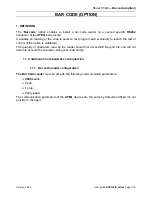
PATTERN ADJUSTMENT
Normal spreading of materials
requires no adjustment (factory
setting “A”) unless stated on the
package. In those cases where the
spread pattern has shifted, the
pattern can be adjusted left and
right by loosening the two knobs on
the discharge chute and moving the
chute closer or farther away from
the impeller. Settings of “A, B, and
C” are provided as reference.
Knob
Discharge
Chute
Impeller
Knob
Discharge Chute
Settings
A simple visual pattern test can be made by
operating the spreader over a non-turf area
and evaluating the pattern. A more accurate
method is to place a row of common,
disposable, aluminum cake pans
approximately 1 foot on centers. Set the rate
plate at a middle setting and make 3 or 4
passes in the same direction as shown.
Pour the material collected from each pan
into individual bottles of the same size. Set
them side by side in order, and visually
inspect their volume. If the pattern is not
centered (example: volume in bottle #2 left
not equal to bottle #2 right), adjust the
discharge chute up or down as described in
“PATTERN ADJUSTMENT” section.
HOW TO DETERMINE SPREADER
SETTINGS AND SPREAD WIDTH
Two major factors should be considered when determining correct spreader settings of any product:
1. The product application rate, or the amount of material applied per 1,000 square feet.
2. The effective pattern width, or the actual width in which material is applied. Label settings are a
guide and can be affected by numerous factors.
EFFECTIVE PATTERN WIDTH
Once the pattern is uniform, the effective pattern width
can be determined. The effective pattern width is the
distance out from the spreader to a point where the
amount of material is 1/2 the average amount in the
center pans. This distance is multiplied by 2 to achieve
the total effective pattern width.


























